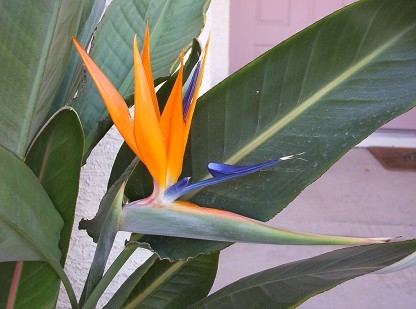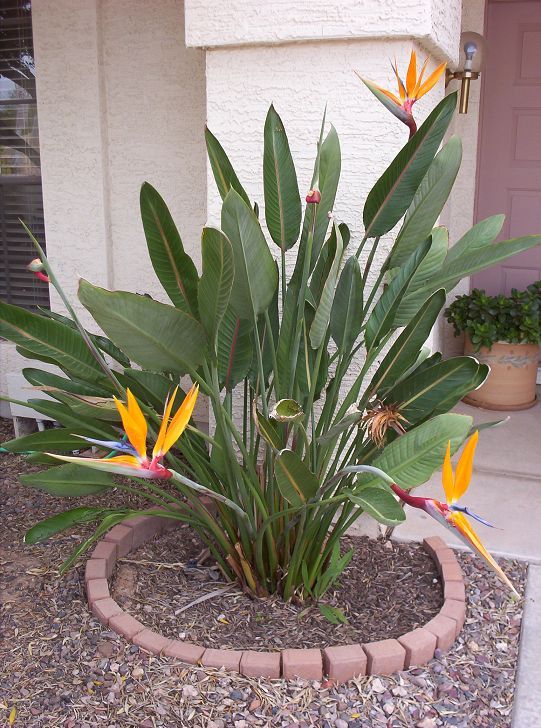|
 Photo
Photo
The flower on the right was photographed in the middle of October. This plant
has been in the ground for over five years and is just starting to produce
a significant number of flowers. It is planted on the North side of the house,
at the opening to a courtyard, where it spends most of its time in light shade.
A single flower head holds on the
plant and looks good for over a month because it continually opens up new flowers from the base to the nose. Flowers are
also long lasting in floral arrangements.
Tropical bird of paradise flowers do not have a scent.
Overview
Tropical bird of paradise plants are relatively easy to grow and make a beautiful landscape plant.
Being related to bananas, they have large dark green leaves that add lushness to the landscape.
Large, colorful, unusual looking flowers are produced during the cooler months. These plants are
also sufficiently heat and cold tolerant, so that they can be grown with little to no protection in the
Phoenix area.
Dr. Barabara Sturm Best anti-aging cream on the market.
Valuable biomimetic lipids support the skin barrier.
Persian Silk Tree Extract reduces the appearance of puffiness and dark shadows and helps lift the upper eye lid.
|

|
Heat Tolerance and Sun Exposure
Tropical bird of paradise plants take both the lower desert heat and sun well but will look more attractive
if kept in Eastern or Northern exposure.
Cold Tolerance
Hardy down to 24 degrees Fahrenheit, freeze damage in the lower desert and especially in the Phoenix
area is not a big concern.
Planting
Dig a hole at least twice the size of the rootball. At a minimum, make the
hole 2 feet in diameter and 1 foot deep.
Work in a 50/50 mix of compost to soil.
Be sure to mix the compost and soil
as thoroughly as possible. It also is a good idea to finish with the
hole an inch or two recessed so that a watering basin is formed.
Watering frequency
Tropical bird of paradise plants do well on a grass watering schedule.
Even though they are related to bananas, they do not get chlorotic or root rot as easily
as bananas do.
Watering method
Basin or flood irrigation
is recommended because it helps keep the salt in our salty
water from accumulating around the roots. Furthermore, deep watering
will encourage the plant to develop deeper roots, making it tougher when the weather
gets hot and dry.

Fertilizing and Growth Rate
Unlike its banana relatives, tropical birds of paradise grow at a slow to moderate rate and therefore consume
a moderate amount of nutrients.
Organic methods can be used to keep it healthy and these methods can also be supplemented with small
amounts of chemical fertilizers.
The simplest and most effective organic fertilizer is
compost which can be spread around the base of the plant at a depth of an inch. Slow release chemical
fertilizers are recommended, and varieties that also acidify the soil will help the plant look greener.
Plants take many years to start blooming so patience is needed. The mature size of a plant is around
4 to 5 feet tall and it is when the plant is around this size and densely packed that it starts to
really produce. Heavily fertilizing the plant does not appear to hasten the onset of blooming so it
is better to keep the plant healthy by supplying nutrients in accordance with its natural growth rate.
Propagation
Propagation is done using both seeds and offsets. See links below for more details.
Pests
Tropical birds of paradise have no significant pest problems in Arizona.
Links to more tropical bird of paradise information
Strelitzia Reginae at Wikipedia

|
Airtags on sale at Amazon!
|
|
 Book the Phoenix Tropicals Condo on Kiahuna Beach, in Kauai, Hawaii
Book the Phoenix Tropicals Condo on Kiahuna Beach, in Kauai, Hawaii